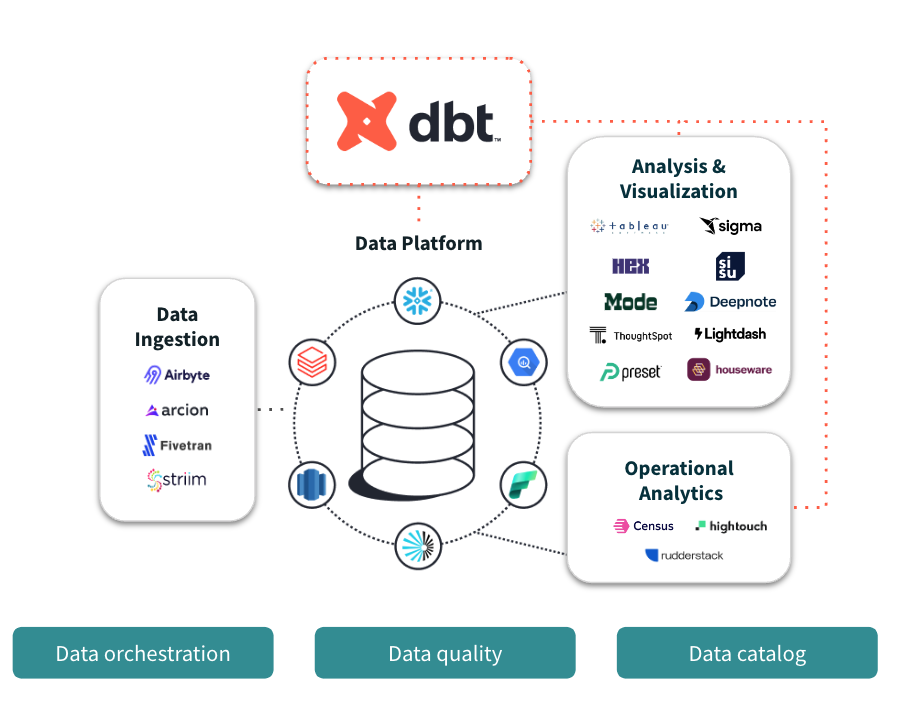What is dbt?
dbt is the industry standard for data transformation. Learn how it can help you transform data and deploy analytics code following software engineering best practices like version control, modularity, portability, CI/CD, and documentation.
dbt is a transformation workflow that helps you get more work done while producing higher quality results. You can use dbt to modularize and centralize your analytics code, while also providing your data team with guardrails typically found in software engineering workflows. Collaborate on data models, version them, and test and document your queries before safely deploying them to production, with monitoring and visibility.
dbt compiles and runs your analytics code against your data platform, enabling you and your team to collaborate on a single source of truth for metrics, insights, and business definitions. This single source of truth, combined with the ability to define tests for your data, reduces errors when logic changes, and alerts you when issues arise.
 dbt works alongside your ingestion, visualization, and other data tools, so you can transform data directly in your cloud data platform.
dbt works alongside your ingestion, visualization, and other data tools, so you can transform data directly in your cloud data platform.Read more about why we want to enable analysts to work more like software engineers in The dbt Viewpoint. Learn how other data practitioners around the world are using dbt by joining the dbt Community.
dbt
Use dbt to quickly and collaboratively transform data and deploy analytics code following software engineering best practices like version control, modularity, portability, CI/CD, and documentation. This means anyone on the data team comfortable with SQL can safely contribute to production-grade data pipelines.
The dbt platform (formerly dbt Cloud)
The dbt platform offers the fastest, most reliable, and scalable way to deploy dbt. Allowing data teams to optimize their data transformation by developing, testing, scheduling, and investigating data models using a single, fully managed service through a web-based user interface (UI).
You can learn about plans and pricing on www.getdbt.com. Learn more about the dbt platform features and try one of the dbt quickstarts.
The dbt Fusion engine
The dbt Fusion Engine is the next-generation dbt engine, designed to deliver data teams a lightning-fast development experience, intelligent cost savings, and improved governance.
For more information, refer to the dbt Fusion Engine, supported features, and the installation instructions pages.
dbt Core
dbt Core is an open-source tool that enables data practitioners to transform data and is suitable for users who prefer to manually set up dbt and locally maintain it. You can install dbt Core through the command line. Learn more with the quickstart for dbt Core.
dbt optimizes your workflow
- Avoid writing boilerplate DML and DDL by managing transactions, dropping tables, and managing schema changes. Write business logic with just a SQL
selectstatement, or a Python DataFrame, that returns the dataset you need, and dbt takes care of materialization. - Build up reusable, or modular, data models that can be referenced in subsequent work instead of starting at the raw data with every analysis.
- Dramatically reduce the time your queries take to run: Leverage metadata to find long-running models that you want to optimize and use incremental models which dbt makes easy to configure and use.
- Write DRYer code by leveraging macros, hooks, and package management.
dbt provides more reliable analysis
- No longer copy and paste SQL, which can lead to errors when logic changes. Instead, build reusable data models that get pulled into subsequent models and analysis. Change a model once and that change will propagate to all its dependencies.
- Publish the canonical version of a particular data model, encapsulating all complex business logic. All analysis on top of this model will incorporate the same business logic without needing to reimplement it.
- Use mature source control processes like branching, pull requests, and code reviews.
- Write data quality tests quickly and easily on the underlying data. Many analytic errors are caused by edge cases in the data: testing helps analysts find and handle those edge cases.
The power of dbt
As a dbt user, your main focus will be on writing models (select queries) that reflect core business logic – there’s no need to write boilerplate code to create tables and views, or to define the order of execution of your models. Instead, dbt handles turning these models into objects in your warehouse for you.
| Loading table... |
Related docs
Was this page helpful?
This site is protected by reCAPTCHA and the Google Privacy Policy and Terms of Service apply.